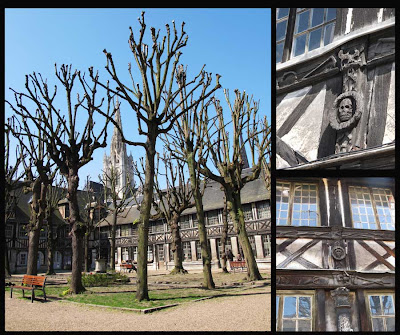Normandy is perhaps best known for three sites: Bayeux (for the tapestry), Mont St Michel and the D-Day beaches.
Getting there from Rouen:
- SNCF train from Rouen to Caen: 1 hr 47 min, ~20 euro each way

- SNCF from Caen to Bayeux: 15 min, 5 euro each way, trains run hourly
- bus service to the D-Day beaches available from Caen (BusVerts)
- tour from Caen or Bayeux to Mont St Michel
- tours by Viator include: Mont St Michel and St Malo: 8 hrs from Bayeaux or Caen, 73 euros Omaha Beach 1/2 day trip from Bayeux: 55 euros, 5 hours
Erwin Rommel: "...the first 24 hours of the invasion will be decisive...the fate of Germany depends on the outcome...for the Allies, as well as Germany, it will be the longest day."At 9:15 p.m. on June 5th, the BBC's French service quoted lines of the 1866 poem Autumn Song by French poet Paul Verlaine.
Les sanglots longsIt was a signal for the French Resistance to start dynamiting the railways. By midnight, Allied planes had begun bombing the Normandy Coast. By 1:30 a.m., June 6th, some 24,000 airborne troops--members of the 101st Airborne along with British, Canadian, and Free French--were parachuting onto German-occupied French soil.
Des violons
De l'automne
Blessent mon cœur
D'une langueur
Monotone.
The long sobs
Of the autumn violins
Wound my heartWith a languidMonotone.
Note: German signals intelligence had determined the Verlaine poem meant an invasion was immeniant. They notified their superiors and all German commanders in France. However, their warning was ignored. A month prior, they had made a previous warning about an Allied invasion that didn't occur. (The Allies had actually delayed the invasion to May due to the weather.)D-Day--June 6, 1944--the "longest day", had begun.
More than 5,000 Allied ships, the largest fleet in history, arrived off the French coast with 150,000 soldiers, 195,000 sailors, landing craft, jeeps and equipment. They began the liberation of Europe by landing on a 50-mile (80 km) section of Normandy beaches codenamed Juno, Gold, Sword, Utah and Omaha.
To their enormous relief, the Allies had obtained complete tactical surprise. D-day, which could have been one of history’s bloodiest disasters, became instead one of its greatest victories.
- Point du Hoc is where US Rangers climbed up the steep (100 ft, 30m) cliff to knock out German bunkers overlooking Omaha and Utah beaches. One of the most impressive of the battle field areas, the areas contains numerous bomb craters and bombed out bunkers. Given to the U.S. by the French, Point du Hoc remains just as it was left on D-Day. Great presentation on Point du Hoc here.

Photo: US Rangers on Pointe du Hoc, June 8, 1944.
The American flag was used to identify their position, preventing incoming Allied fire. From here.
Caen
Because of extensive damage during WW2 (see Battle of Caen), most of the medieval buildings were destroyed. Best known for historical buildings built during the reign of William the Conqueror.
- Le Chateau Ducal: Built in 1060 by William the Conquerer to house his residential palace. The palace became one of the largest fortified residences in Europe. Heavily damaged during WWII. Wander through the ruins on walkways or climb the wide steps to the ramparts for a fine view of the city and St. Peters Church. video
- Museum of Fine Arts: On the grounds of Le Chateau Ducal.
- Musee de Normandie (Normandy Museum): On the grounds of Le Chateau Ducal.
- Abbaye aux Dames: Founded by Mathilda, wife of William the Conqueror, this abbey embraces Eglise de la Trinité, which is flanked by Romanesque towers. Its spires were destroyed in the Hundred Years' War. The 12th-century choir houses the tomb of Queen Mathilda; note the ribbed vaulting
- Abbaye aux Homes: Founded by William the Conqueror local Caen stone (also used for Canterbury Cathedral, Westminster Abbey, and the Tower of London). The Huguenots destroyed the tomb in 1562 -- only a hipbone was recovered. During the French Revolution, the last of William's dust was scattered to the wind. The hand-carved wooden doors and elaborate wrought-iron staircase are exceptional.
- Memorial for peace, a World War II museum.




























